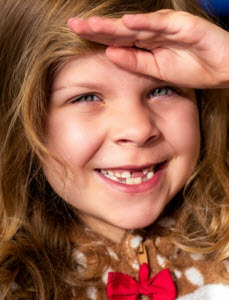As tempting as it may be, you shouldn’t pull a loose tooth when it first loosens up. It can be more challenging for your child to eat and speak properly when a baby tooth becomes loose. As a result, many people want to try and yank that tooth out for the best interest of your child. However, pulling a loose tooth too soon can actually be harmful, and pretty painful. There are a number of reasons why teeth may become loose in addition to them preparing to shed. For instance, if a tooth becomes loose due to an injury, pulling it out will definitely be painful, likely cause excessive bleeding, and potentially lead to permanent dental damage. Ultimately, when your child’s tooth is ready to come out, it is best to let nature run its course. There are ways you can support the process and encourage the loose tooth to shed, though you shouldn’t pull the loose tooth out until it’s 100% ready. With this in mind, we at Smile Reef would like to continue to discuss pulling your child’s loose tooth.
How Do You Get a Child’s Loose Tooth Out Without it Hurting?

1) Loosening the baby tooth above is due to an underlying permanent tooth starts to grow.
2) While pushing the baby tooth upward, the permanent tooth starts to absorb the root of the baby tooth.
3) The permanent tooth will have absorbed the entire baby tooth root up to about 6 months after the baby tooth loosens up
4) The gum tissue is the only thing holding it in place once the baby tooth has been pushed out of the gums. This is when the baby tooth is ready to come out.
How Do You Know when a Loose Tooth is Ready to Be Pulled?
It’s ready to be removed when the tooth can be twisted nearly 360 degrees, without pain. To try to remove the tooth, you can apply very gentle pressure. Stop pulling the tooth and try one of these tricks below if your child is in pain.
1) Have the child bite into an apple. The pressure of biting into the apple should be enough to pop the tooth out.
2) To encourage the tooth to detach too, your child can try brushing and/or flossing his or her teeth.
3) The American Dental Association (ADA) recommends that you wash your hands, place a paper towel over the tooth, and gently squeeze it if your child asks for help removing the tooth, and they’re not experiencing pain.
Should I Be Concerned About Gum Tissue Left Behind After the Baby Tooth is Removed?
After the baby tooth comes out, it is possible that your child is left with a piece of gum tissue hanging. The tissue remnants are common and usually doesn’t require any attention. Do not attempt to remove the tissue as it can be excessively painful and dangerous if you remove healthy gum tissue. Allow the piece to come off naturally instead. The gum tissue should detach on its own by eating, brushing, and flossing normally.
Pediatric Dentistry
In addition to brushing and flossing, be sure to schedule a dental visit every 6 months. Call Smile Reef and let our professionals take care of your child’s professional oral care.
